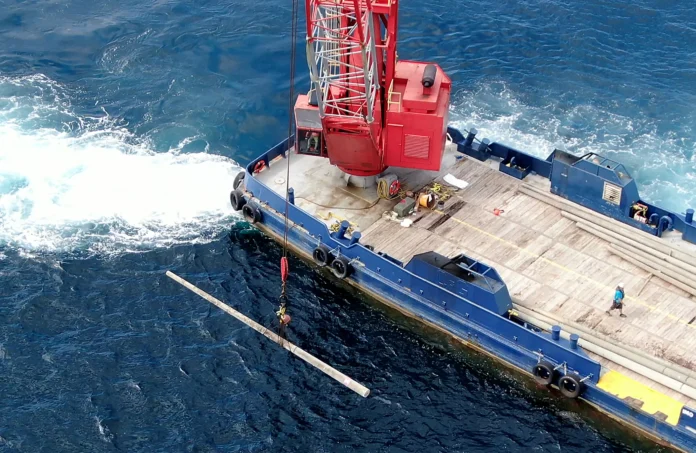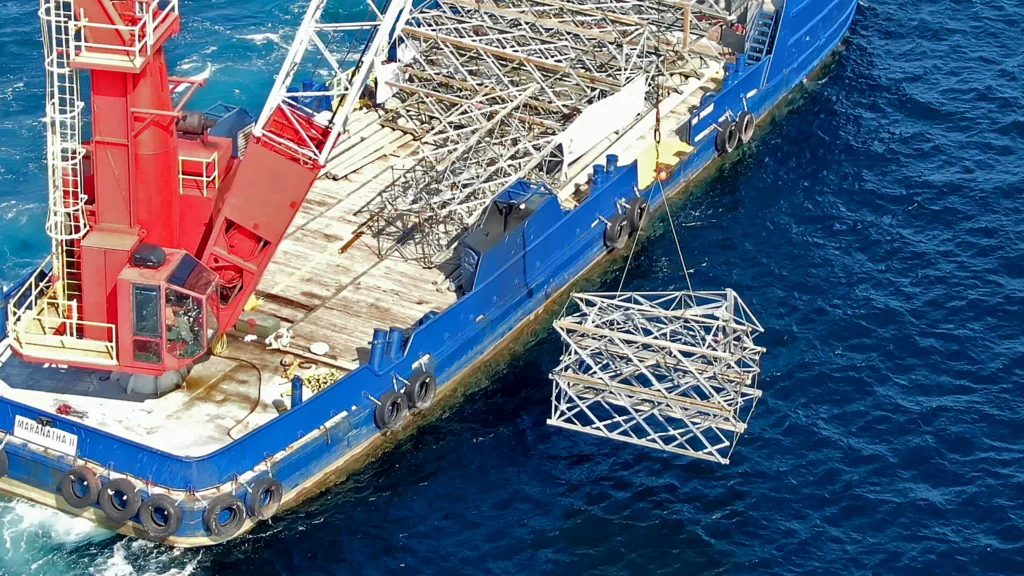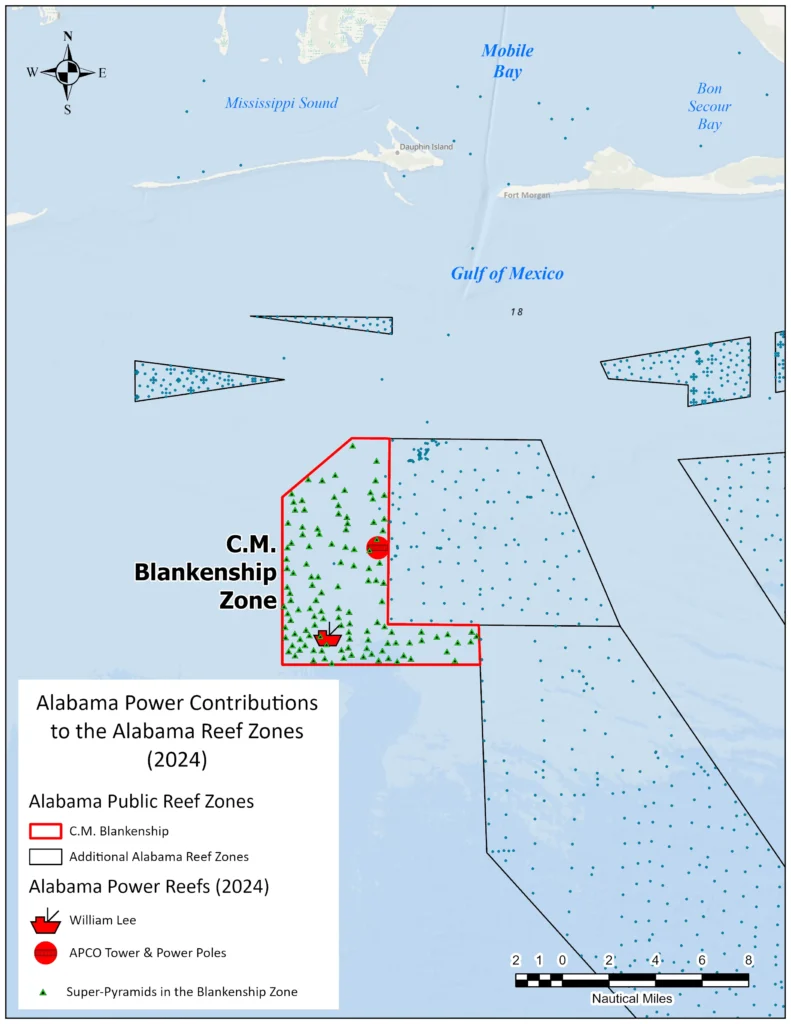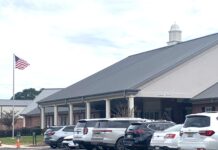
With landfills reaching capacity, what could be a better way to repurpose decommissioned equipment than using it to build habitat for Alabama’s great offshore fisheries?
Alabama Power Company recently teamed up with the Alabama Department of Conservation and Natural Resources’ (ADCNR) Marine Resources Division (MRD) to take end-of-life concrete poles and tower segments to build a new reef in the (Conservation Commissioner) Christopher M. Blankenship Reef Zone that covers 65 miles of Gulf of Mexico bottom between 10 and 20 miles off the Alabama coast.
Both Jason Carlee, Alabama Power’s Manager of Water Field Services in the Environmental Affairs Division, and Craig Newton, MRD’s Artificial Reef Coordinator, noted the arrangement of the concrete poles in the September 19 deployment reminded them of the old game Pick Up Sticks.
“We appreciate the opportunity to partner with the state,” Carlee said. “This is the fourth reef that Alabama Power has deployed. This reef used concrete distribution and transmission poles and steel lattice from transmission towers. We used The Reefmaker out of Orange Beach to deploy the material, and Stewart Walter is very accurate with where he puts the material. The goal was to stack the poles in a crisscross pattern, kind of like Pick Up Sticks, to get some relief and not just lying flat on the bottom. He also added some transmission tower segments among the poles. There is a lot of surface area on those concrete poles for barnacles and other marine life to get that reef complex started.”
Newton, who oversees Alabama’s unparalleled reef zones that cover more than 1,200 square miles of bottom on the Gulf of Mexico, said the Blankenship Reef Zone was permitted in 2021 and named in honor of the Commissioner by Governor Kay Ivey. Soon after the permit was issued, MRD started deploying reefs in the zone and ended with 123 reefs using 164 super pyramid reef structures before the latest deployments.
“We developed a mutually beneficial partnership with Alabama Power, and they repurposed these concrete power poles and other material to construct this additional reef in the Blankenship Reef Zone that significantly increased the diversity of habitat types that are available to the reef fish in that area,” Newton said. “The concrete poles provide a unique habitat that is different from the 25-foot-tall concrete pyramids in that there are more nooks and crannies for fish, crabs and invertebrates to seek refuge and inhabit. It’s an exceptionally diverse reef habitat in 90 feet of water.
“I’m not sure kids today would know what Pick Up Sticks are, but, if you can, picture a configuration that resembles Pick Up Sticks in the way these concrete poles were deployed. In addition to the power poles, sections of a transmission tower were deployed adjacent to and on top of the power poles. That provides higher vertical relief and also a significant number of small, interstitial spaces.”
Newton said the reef will be prime habitat for red snapper, Alabama’s signature reef species, as well as gray triggerfish and gray (mangrove) snapper.
“It should be especially productive for producing gray snapper,” he said. “Their behavior is such that they prefer to have relatively tight, close quarters with the habitat. This power pole configuration and the transmission tower sections will provide this unique habitat for the gray snapper to thrive in.”
Commissioner Blankenship foresees a long relationship with Alabama Power to continue building reefs off the Alabama coast.
“I appreciate the reef-building partnership with Alabama Power,” Commissioner Blankenship said. “Their commitment to sustainability by repurposing end-of-service-life material to create new living habitat for marine organisms is commendable. The Alabama Power staff and leadership have been great to work with. I look forward to many future projects.”

Sections of a decommissioned transmission tower were added to create a reef complex. Photo by Mark Jerald
With the assistance of Alabama Power, MRD also deployed another reef in the Blankenship Reef Zone, but it was a decommissioned tugboat, the William Lee. The tugboat was donated by Hooks Towing from Chickasaw, Alabama, and Alabama Power provided the funding for the deployment.
The tugboat was 45 feet long and 25 feet wide. The William Lee was deployed 17 miles south of Dauphin Island in the Blankenship Reef Zone.
“The William Lee tugboat was cleaned and fully remediated to remove any compounds that would not be conducive to the marine environment,” Newton said. “The empty steel hull had holes cut in so that the fish could utilize the entire structure. The William Lee rests on the bottom about 105 feet below the surface and extends about 15-17 feet into the water column.
“It will be good habitat not only for the typical red snapper and triggerfish but also greater amberjack. The water is a little too shallow to be considered a really good amberjack reef, but during certain times of the year and certain environmental conditions, we do expect there to be good amberjack on this reef.”
Alabama Power started its reef deployment activity when it partnered with Cooper/T. Smith (CTS) and the Alabama Wildlife Federation (AWF) to deploy its first artificial reef in the Gulf of Mexico in 2016. Two retired boilers from plants in Washington County and Theodore were loaded and secured on a CTS salvage hopper barge and deployed in a zone 25 miles southeast of Dauphin Island.
In 2019, three 13-foot by 26-foot storage tanks from Washington County and Barry plants were repurposed and deployed by The Reefmaker as the first reefs into the newly established AWF Nearshore Artificial Reef Zone.
In November 2021, Alabama Power deployed another retired package boiler and other material from the Washington County Gogen plant. The material was again welded inside a CTS salvage barge and deployed into the AWF Nearshore Artificial Reef Zone.
Alabama Power’s Carlee pointed out these reefs provide multiple benefits for Alabamians.
“Alabama has created a world-class offshore reef fishery, and I understand that other states are trying to model what’s being done in Alabama,” Carlee said. “That’s tremendous for recreational and commercial fishing. It’s also incredible for economic development, bringing tourists from out of state to fish those reefs.
“But it is wonderful to be able to partner with the state and find a way to repurpose materials that have ended their useful life in our system. It’s better for the customer as well as us to repurpose it instead of taking up landfill space. The state has done a tremendous job of managing the reef system.”
Newton said there are currently about 10,000 artificial reefs within the 1,200 square miles of reef bottom in the Alabama Artificial Reef Program (www.outdooralabama.com/saltwater-fishing/artificial-reefs).
“The private sector has been extremely important to reef construction offshore of Alabama,” he said. “That’s what really sets our program apart from other programs. It’s the partnerships we’ve made with the private sector, where private entities can go through a simple permitting process and construct their own reefs.
“Over the past seven or eight years, we went through a significant expansion of what was already an amazing artificial reef program.”
MRD gained permits for an additional 60 square miles of water bottom between 6 and 9 miles offshore as well as added the 65 square miles of bottom in the Blankenship Reef Zone. With remediation from the Deepwater Horizon oil spill, MRD deployed several thousand new reef modules in the new reef zones.
“We really kind of changed the dynamics of the fishery and provided significantly more access to the reef fish populations by adding these nearshore artificial reefs,” Newton said. “For example, a family can go 6-7 miles on an afternoon trip and have a respectable chance of catching good red snapper. Prior to this expansion, that just wasn’t possible because of the limited amount of habitat. We have greatly increased the accessibility to the natural resource with the development of these new reefs.”

Locations of the new reefs and super pyramids in the Blankenship Reef Zone are highlighted.


















